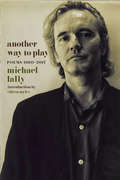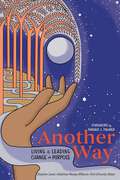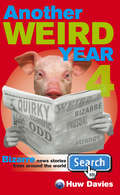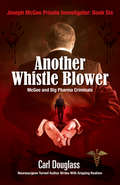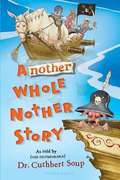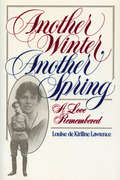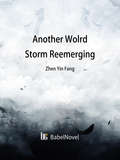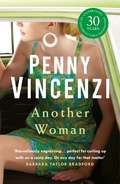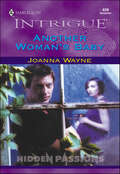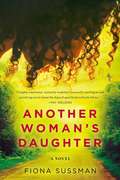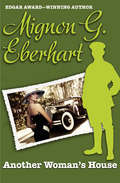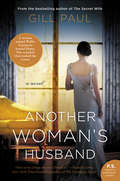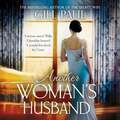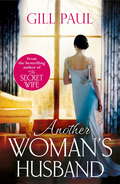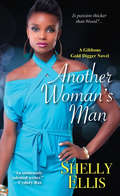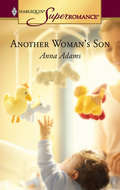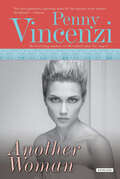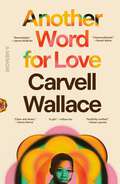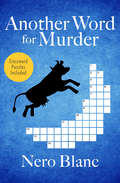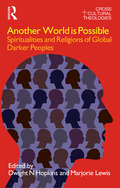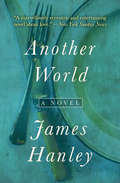- Table View
- List View
Another Way to Play: Poems 1960-2017
by Michael Lally Eileen MylesThe collected works of a poet who bridges the rhythms and message of the beats, the disarming frankness of the New York School, and the fierce temerity of activist authors throughout the ages.From a '60s-era verse letter to John Coltrane to a 2017 examination of Life After Trump, Another Way to Play collects more than a half century of engaged, accessible, and deeply felt poetry from a writer both iconoclastic and embedded in the American tradition. In the vein of William Carlos Williams and Frank O'Hara, Lally eschews formality in favor of a colloquial idiom that pops straight from the page into the reader's synapses. This is the definitive collection of verse from a poet who has been around the world and back again: verse from the streets, from the the political arena, from Hollywood, from the depths of the underground, and from everywhere in between. Lally is not a poet of any one school or style, but a poet of his own inner promptings; whether casual, impassioned, or ironic, his words are unmistakably his own. Here is a poet who can hold two opposed ideas in mind simultaneously, and fuse them, with pathos and humor, into his own idiosyncratic verbal art. As Lally himself writes: "I suffered, I starved, and so did my kids, / I did what I did for poetry I thought /and I never sold out, and even when I did / nobody bought."
Another Way...Choosing to Change: Participant's Handbook
by Nada J YorkeAnother Way...Choosing to Change: Participant's Handbook supports individuals as they progress through a facilitator-led, strengths-based, solution-focused batterer intervention program. The handbook presents participants with an intentional and strategic collection of questions and exercises designed to support transformational learning and promote empathy building. <P><P>This unique curriculum combines evidence-based clinical practices with adult learning principles to promote changes in the thoughts, feelings, and actions of participants. It educates participants on what constitutes abusive behaviors, encourages introspection, promotes personal responsibility for abusive behaviors, and teaches non-violent conflict resolution.
Another Way: Living and Leading Change on Purpose
by Stephen Lewis;Matthew Wesley Williams;Dori Grinenko BakerAnother Way describes a new way of leadership for the 21st Century, one that inspires people to delve deeply into their own selves and that creates a mysterious relatedness among strangers. When this leadership happens, we remember people are created to experience community, to find joy in one another, and to create a better world out of a deep reservoir where the soul resides. Written by the leaders of the Forum for Theological Exploration, the internationally recognized leadership incubator for emerging Christian leaders, Another Way will shape the way you look at yourself, your leadership, and the communities that hold you accountable to making the world a better place.
Another Weird Year 4
by Huw DaviesIn time-honoured fashion, Another Weird Year 4 brings you the stories that no lover of bizarre, inexplicable and downright hilarious news items can afford to miss, all handily grouped by theme (Love and Marriage, Law and Order, Animals etc). Read about: the blind man banned from saying 'phlegm'; the woman who bored a burglar to sleep with her family snaps; the woman who seduces men in her sleep; the man who thought he was a cat and got stuck up a tree; another man who got out of his car and took a shower... in a car wash... with his car left outside; the shepherd that had to drive his drunk sheep home; and not forgetting the pigs given a sauna and massage before being taken for slaughter - proof again from Another Weird Year that there is humanity in even the weirdest human behaviour. All the stories are true - you couldn't make them up!
Another Whistle Blower: McGee and Big Pharma Criminals
by Douglass CarlAnother Whistle Blower is the sixth and final novella of Carl Douglass's McGee series. Pharmacist Cecil Edgington strikes it rich when he joins a pharmaceutical consortium to market a cancer wonder drug. Or is it too good to be true? He learns a little more, begins to suspect much more; and finally, he gets downright scared. That is when he seeks to counsel, assistance, and protection of McGee & Associates. McGee uncovers a vast conspiracy, a dangerous cabal, and a labyrinthine source of riches beyond his greatest imaginations. Cecil has a life-altering decision to make: should he stay with the consortium and get rich? Or should he become a whistleblower and live as a fugitive? That decision is the stuff of a riveting book and a life's lesson.
Another Whole Nother Story
by Cuthbert SoupIn this sequel to "A whole nother story," Ethan Cheeseman takes his children, ages eight, twelve, and fourteen, and Captain Jibby and crew, to the year 1668 to end an ancient family curse and save the children's mother, but damage to the time machine and the arrival of Mr. 5 complicate their return.
Another Winter, Another Spring: A Love Remembered
by Louise De LawrenceSet at the turn of the twentieth century and spread across the enormous canvas of Russia itself, Another Winter, Another Spring is a tale of love and loyalty tested against great hardship and suffering.
Another Wolrd: Volume 1 (Volume 1 #1)
by ZhenyinfangLinghu Feng is young and unfortunate. His family is destroyed. He has a deep blood feud. In order to revenge, I want to join the Magic Dragon Castle. Encounter the enemy's pursuit halfway, kill the enemy and get swallowed.Join the Magic Dragon Castle and get the magic heart skill. From the five elements gate, we can get the true understanding of five elements; from the Yin Yang sect, we can get the true understanding of yin and Yang. It integrates swallowing and absorption, and creates its own unique Linghu magic power.Linghu Feng's strength, in a little bit stronger, finally in the understanding of the Shinto, became the strongest God King. In the first battle of yunhaifeng, we killed the rival sects, killed another God King, and became the invincible God King.
Another Woman
by Penny VincenziFamily secrets and a shattering scandal emerges when a dream wedding becomes a nightmare - and the bride disappears. 'Like a glass of champagne: bubbly, moreish and you don't want it to end' Daily Express The night before her lavish wedding to Oliver Bergin, Cressida Forrest went to bed serene and happy. By morning she had vanished - without apparent cause, and without trace. Shocked, anxious and uncomprehending, the two families face a long and painful day of revelations, as a complex, fragile web of sexual, marital and financial secrets is ripped apart by Cressida's disappearance. And the question they are all forced to ask is who really was the woman they thought they knew - perfect daughter, sister, lover and wife never to be?'Deliciously readable' Mail on Sunday
Another Woman
by Penny VincenziFamily secrets and a shattering scandal emerges when a dream wedding becomes a nightmare - and the bride disappears. 'Like a glass of champagne: bubbly, moreish and you don't want it to end' Daily Express The night before her lavish wedding to Oliver Bergin, Cressida Forrest went to bed serene and happy. By morning she had vanished - without apparent cause, and without trace. Shocked, anxious and uncomprehending, the two families face a long and painful day of revelations, as a complex, fragile web of sexual, marital and financial secrets is ripped apart by Cressida's disappearance. And the question they are all forced to ask is who really was the woman they thought they knew - perfect daughter, sister, lover and wife never to be?'Deliciously readable' Mail on Sunday
Another Woman's Baby (Hidden Passions)
by Joanna WayneTravel with Joanna Wayne deep into the American South as she unlocks HIDDEN PASSIONSHOME FOR THE HOLIDAYS...WITH A TALL, DARK, SEXY STRANGERSurrogate mother Megan Lancaster had been prepared for what pregnancy would bring-only, an FBI hunk stringing lights on her Christmas tree wasn't one of those things! But her life was in danger, and agent Bart Cromwell, masquerading as her adoring lover, would protect her and her baby.Her baby.The child she carried no longer had parents...unless Megan and the sexy stranger who kept kissing her under the mistletoe were willing to put their hearts on the line and welcome the newborn as a family...for Christmas and forever.
Another Woman's Daughter
by Fiona SussmanSet against the tumultuous background of apartheid South Africa, a powerful and moving debut about family, sacrifice, and discovering what it means to belong... Celia Mphephu knows her place in the world. A black servant working in the white suburbs of 1960s Johannesburg, she's all too aware of her limitations. Nonetheless, she has found herself a comfortable corner: She has a job, can support her faraway family, and is raising her youngest child, Miriam. But as racial tensions explode, Celia's world shifts. Her employers decide to flee the political turmoil and move to England--and they ask to adopt Miriam and take her with them. Devastated at the prospect of losing her only daughter, yet unable to deny her child a safer and more promising future, Celia agrees, forever defining both their futures. As Celia fights against the shattering violence of her time, Miriam battles the quiet racism of England, struggling to find her place in a land to which she doesn't belong--until the call of her heritage inexorably draws her back to Africa to discover the truth behind her mother's choices and uncover a heartbreaking secret from long ago...READERS GUIDE INSIDEFrom the Trade Paperback edition.
Another Woman's House
by Mignon G. EberhartA young girl is consumed by love for a tortured married manMyra has lived at Thorne House for so long that she almost feels part of the family. Orphaned at a young age, she has never known another home, and yet it is time for her to leave. She is burning with an irresistible passion for Richard, the man of the house, and she knows that her love can never be fulfilled. For Richard is married to Alice, and Alice is guilty of murder. Myra knows that Richard is too noble to ask an incarcerated woman for a divorce, but on the eve of her departure he surprises her, confessing that he loves her in return. Just as Myra&’s future happiness seems assured, Alice returns to crush it. The convicted killer is back at Thorne House, and blood will follow in her wake.
Another Woman's Husband: A Novel
by Gill PaulAs the world mourns the loss of Diana, Princess of Wales, one young woman uncovers a forgotten story of passion, betrayal, and a scandal surrounding the British crown in this unforgettable novel by the bestselling author of The Secret Wife. Two women who challenged the Crown.Divided by time. Bound by a secret...1911: When fifteen-year-old Mary Kirk meets Wallis Warfield at summer camp, she’s immediately captivated by her fearless, brazen, and self-assured personality. And Wallis has a way with the boys who are drawn to her like moths to a flame. Though Mary’s family isn’t crazy about her new best friend, she steadfastly stands by her side—even years later when they’re adults and rumors swirl about Wallis and her reckless behavior with none other than the Prince of Wales. But when Mary’s loyalty to Wallis comes into question, their friendship will be put to the ultimate test.1997: After a romantic proposal in Paris, Rachel and her fiancé Alex are in a cab when suddenly the car ahead crashes. They’re stunned to learn Princess Diana is in the car. By the wreckage, Alex finds a heart pendant with an engraved letter “J” and Roman numerals XVII and gives it to Rachel to hold. Haunted by the crash and Diana’s subsequent death, Rachel is intrigued when she discovers that Di had visited the last home of Wallis, the Duchess of Windsor, only hours before the accident. Eventually, the revelation of a long-forgotten link to Wallis Simpson leads Rachel to the truth behind a scandal that shook the world...
Another Woman's Husband: From the #1 bestselling author of The Secret Wife a sweeping story of love and betrayal behind the Crown
by Gill PaulFrom the #1 bestselling author of The Secret Wife, Another Woman's Husband will be adored by all fans of The Crown. Wallis Simpson is brought enticingly to life in this gripping, moving novel about two women thrust into the spotlight, followed by scandal, touched by loss.'One of my favourite books of this year. Fascinating, glamorous and utterly compelling... historical fiction at its best' Tracy Rees, author of The Hourglass.'Another Woman's Husband is a marvellous, perfect read' The SunTwo women who challenged the Crown.Divided by time. Bound by a secret...1911At the age of fifteen, carefree Mary Kirk and indomitable Wallis Warfield meet at summer camp. Their friendship will survive heartbreaks, separation and the demands of the British Crown until it is shattered by one unforgivable betrayal...1997Rachel's romantic break in Paris with her fiancé ends in tragedy when the car ahead crashes. Inside was Princess Diana. Back in Brighton, Rachel is haunted by the accident, and intrigued to learn the princess had visited the last home of Wallis, Duchess of Windsor, only hours before the crash. Soon, the discovery of a long-forgotten link to Wallis Simpson leads Rachel to the truth behind a scandal that shook the world...Readers love ANOTHER WOMAN'S HUSBAND:'Riveting! I thoroughly enjoyed this intriguing tale of friendship and betrayal' Rosanna Ley'With superb story-telling and a lush backdrop of period detail...a novel that is impossible to put down, about two women who are impossible to forget. I loved it!' Hazel Gaynor'I devoured Another Woman's Husbandin a few days. This has bestseller written all over it.' Louise Beech'With seamless ease Gill evokes the events and characters of two eras...with great verve and a smattering of delicious fictional licence. Delightful' Liz Trenow'Gill Paul has taken two of the twentieth century's most enigmatic women, one revered, the other reviled, and woven them into a deft story of friendship and betrayal' Kate Riordan'Compelling and full of surprises ****' The Lady'Sheds light on a scandal and a love story which deserves to be read by many. A fascinating read which made me lose several hours to this story. I have no hesitation in recommending it and am keen to see what time in history Gill Paul will turn her hand to next' Shaz's Book Blog
Another Woman's Husband: From the #1 bestselling author of The Secret Wife a sweeping story of love and betrayal behind the Crown
by Gill PaulFrom the #1 bestselling author of The Secret Wife, Another Woman's Husband will be adored by all fans of The Crown. Wallis Simpson is brought enticingly to life in this gripping, moving novel about two women thrust into the spotlight, followed by scandal, touched by loss.'One of my favourite books of this year. Fascinating, glamorous and utterly compelling... historical fiction at its best' Tracy Rees, author of The Hourglass.'Another Woman's Husband is a marvellous, perfect read' The SunTwo women who challenged the Crown.Divided by time. Bound by a secret...1911At the age of fifteen, carefree Mary Kirk and indomitable Wallis Warfield meet at summer camp. Their friendship will survive heartbreaks, separation and the demands of the British Crown until it is shattered by one unforgivable betrayal...1997Rachel's romantic break in Paris with her fiancé ends in tragedy when the car ahead crashes. Inside was Princess Diana. Back in Brighton, Rachel is haunted by the accident, and intrigued to learn the princess had visited the last home of Wallis, Duchess of Windsor, only hours before the crash. Soon, the discovery of a long-forgotten link to Wallis Simpson leads Rachel to the truth behind a scandal that shook the world...Readers love ANOTHER WOMAN'S HUSBAND:'Riveting! I thoroughly enjoyed this intriguing tale of friendship and betrayal' Rosanna Ley'With superb story-telling and a lush backdrop of period detail...a novel that is impossible to put down, about two women who are impossible to forget. I loved it!' Hazel Gaynor'I devoured Another Woman's Husband in a few days. This has bestseller written all over it.' Louise Beech'With seamless ease Gill evokes the events and characters of two eras...with great verve and a smattering of delicious fictional licence. Delightful' Liz Trenow'Gill Paul has taken two of the twentieth century's most enigmatic women, one revered, the other reviled, and woven them into a deft story of friendship and betrayal' Kate Riordan'Compelling and full of surprises ****' The Lady'Sheds light on a scandal and a love story which deserves to be read by many. A fascinating read which made me lose several hours to this story. I have no hesitation in recommending it and am keen to see what time in history Gill Paul will turn her hand to next' Shaz's Book Blog
Another Woman's Husband: From the #1 bestselling author of The Secret Wife a sweeping story of love and betrayal behind the Crown
by Gill PaulANOTHER WOMAN'S HUSBAND is the latest gripping novel from Gill Paul. 'A triumph' Dinah Jefferies on the USA Today bestselling The Secret WifeTwo women who challenged the Crown.Divided by time. Bound by a secret...1911At the age of fifteen, carefree Mary Kirk and indomitable Wallis Warfield meet at summer camp. Their friendship will survive heartbreaks, separation and the demands of the British Crown until it is shattered by one unforgivable betrayal.1997Rachel's romantic break in Paris with her fiancé ends in tragedy when the car ahead crashes. Inside was Princess Diana. Back in Brighton, Rachel is haunted by the accident, and intrigued to learn the princess had visited the last home of Wallis, the Duchess of Windsor, only hours before the crash. Soon, the discovery of a long-forgotten link to Wallis Simpson leads Rachel to the truth behind a scandal that shook the world...Richly imagined and beautifully written, ANOTHER WOMAN'S HUSBAND is a gripping, moving novel about two women thrust into the spotlight, followed by scandal, touched by loss.(P)2017 Headline Publishing Group Ltd
Another Woman's Husband: The USA TODAY bestseller from the Globe and Mail bestselling author of The Secret Wife, a sweeping story of love and betrayal behind the Crown
by Gill PaulFrom the #1 bestselling author of The Secret Wife comes a gripping novel that commences with the tragic death of Diana, Princess of Wales, and journeys back to the fascinating world of Wallis Simpson, Duchess of Windsor. 'A triumph' Dinah Jefferies on The Secret Wife by Gill PaulTwo women who challenged the Crown.Divided by time. Bound by a secret...1911At the age of fifteen, carefree Mary Kirk and indomitable Wallis Warfield meet at summer camp. Their friendship will survive heartbreaks, separation and the demands of the British Crown until it is shattered by one unforgivable betrayal.1997Rachel's romantic break in Paris with her fiancé ends in tragedy when the car ahead crashes. Inside was Princess Diana. Back in Brighton, Rachel is haunted by the accident, and intrigued to learn the princess had visited the last home of Wallis, Duchess of Windsor, only hours before the crash. Soon, the discovery of a long-forgotten link to Wallis Simpson leads Rachel to the truth behind a scandal that shook the world...Richly imagined and beautifully written, ANOTHER WOMAN'S HUSBAND is a gripping, moving novel about two women thrust into the spotlight, followed by scandal, touched by loss.
Another Woman's Man (A Gibbons Gold Digger Novel #3)
by Shelly Ellis"An immensely talented writer." –Cydney RaxThe notorious gold digging Gibbons women of Chesterton, Virginia, are minding their own highly-paid business when second eldest sister, Dawn, is reunited with the one man she never dreamed she'd see again. . .Dawn Gibbons is shocked when her long-lost father reappears in her life. Seriously ill, his dying wish is to reconnect with her. But for Dawn, it's complicated--her wealthy father comes complete with jealous relatives--and a handsome young lawyer Dawn finds dangerously sexy. Dangerous because he's engaged--to her newfound half-sister. One thing a Gibbons woman doesn't do is steal her sister's man. Yet for the first time, Dawn may care about love more than money. . .Xavier Hughes isn't easily thrown, but the electricity between him and Dawn leaves him unsettled. And when his suspicious fiancée insists he investigate Dawn's background, it only pushes him closer to the one woman he should resist. Soon, holding back isn't an option, and both Xavier and Dawn will have to face the consequences of breaking the family rules. . . "Can't Stand the Heat is a deliciously sultry, sexy novel. It serves up the perfect recipe of lies, love and lots of drama, making it a must-read."--Daaimah S. Poole "Be ready to laugh and cry with these new reality stars of Chesterton, Va." – RT Book Reviews, 4 stars
Another Woman's Son
by Anna AdamsWhose baby is he?Three months ago, Isabel Baker's life came crashing down after her husband confessed he'd fallen in love with another woman-her sister-and that they'd had a child together.Then tragedy strikes, and Isabel's sister and husband are killed, leaving baby Tony with just her sister's husband, Ben. Now Isabel is faced with a terrible decision. Telling the truth would mean taking Tony from the only father he's ever known, but how can she possibly lie?She's shocked to discover that Ben doesn't have any such qualms. He's determined to keep what remains of his family intact-no matter what. Which is why he's trying to convince Isabel that together they could make the perfect parents for Tony....
Another Woman: A Novel
by Penny VincenziA dream wedding becomes a nightmare -- as the bride disappears ... The night before her lavish wedding to Oliver Bergin Cressida Forrest went to bed serene and happy. By morning she had vanished -- without apparent cause, and without trace. Shocked, anxious and uncomprehending, the two families face a long and painful day of revelations, as a complex, fragile web of sexual, marital and financial secrets is ripped apart by Cressida's disappearance. And the question they are all forced to ask is who really was the woman they thought they knew -- perfect daughter, sister, lover and wife never to be?
Another Word for Love: A Memoir
by Carvell WallaceA transformative memoir that reimagines the conventions of love and posits a radical vision for healing. In Another Word for Love, Carvell Wallace excavates layers of his own history, situated in the struggles and beauty of growing up Black and queer in America.Wallace is an award-winning journalist who has built his career on writing unforgettable profiles, bringing a provocative and engaged sensitivity to his subjects. Now he turns the focus on himself, examining his own life and the circumstances that frame it—to make sense of seeking refuge from homelessness with a young single mother, living in a ghostly white Pennsylvania town, becoming a partner and parent, raising two teenagers in what feels like a collapsing world.With courage, vulnerability, and a remarkable expansiveness of spirit—not to mention a thrilling, and unrivaled, storytelling verve—Another Word for Love makes an irresistible case for life, healing, the fullness of our humanity, and, of course, love. It could be called a theory of life itself—a theory of being that will leave you open to the wonder of the world.
Another Word for Murder (Crossword Mysteries #10)
by Nero BlancMurder moves into the neighborhood in this witty and suspenseful crossword mystery featuring husband-and-wife sleuth team Belle Graham and Rosco Polycrates Belle Graham and her canine bodyguards, Kit and Gabby, are enjoying their daily outing in the local dog park with new friends Karen Tacete, her daughter Lily, and their dog Bear. But Karen&’s picture-perfect life shatters when her husband, Dan, fails to return home. He&’s barely been declared officially missing when Karen receives a ransom note that includes a dire warning: If she contacts the police or the FBI, Dan dies. Who would kidnap the popular dentist against whom no one ever had a cross word? That&’s what Belle and her husband, PI Rosco Polycrates, need to find out. When the Tacete abduction escalates to murder, Belle and Rosco realize the solution may lie in the baffling nursery rhyme–themed crosswords Belle has been receiving. As they dig into the life of Newcastle&’s most charitable DDS, they soon find themselves up to their eyeteeth in danger, racing to fill in the blanks of a plan orchestrated by someone out to make a killing. This ebook includes six crossword puzzles that can be downloaded as PDFs, with answers in the back of the book.Another Word for Murder is the 7th book in the Crossword Mysteries, but you may enjoy reading the series in any order.
Another World is Possible: Spiritualities and Religions of Global Darker Peoples (Cross Cultural Theologies Ser.)
by Dwight N. Hopkins Marjorie Lewis'Another World is Possible' examines the many peoples who have mobilized religion and spirituality to forge identity. Some claim direct links to indigenous spiritual practices; others have appropriated externally introduced religions, modifying these with indigenous perspectives and practices. The voices of Black people from around the world are presented in essays ranging from the Indian subcontinent, Japan and Australia to Africa, the UK and the USA. From creation narratives to trickster heroes, from the role of spirituality in HIV positive South Africa to its place in mental health and among the poor, spirituality is shown to be essential to the survival of individuals and communities.
Another World: A Novel
by James HanleyIn a lonely seaside town, a few misfits cling to one another for survival Nine months ago, Mrs. Gandell left Yorkshire behind. She invested what little money she had in a ramshackle inn off the coast of Wales, in a forgotten resort town called Garthmeilo. At the time, it was summer, light and warm. Now it is February, and the Welsh gloom has ground Mrs. Gandell&’s spirit to dust. Her only companion is Jones, a bitter handyman who delights in torturing his employer. Nothing sustains them but gin and cigarettes—and the gin is running out. The winter has been brutal, with only one lodger to keep the Decent Hotel afloat: an enigmatic dreamer named Miss Vaughan. When the local vicar takes an interest in her, it throws their lives into chaos. Mrs. Gandell wants nothing more than to sell the inn and return to Yorkshire, but February is endless, and Garthmeilo may prove to be inescapable.
